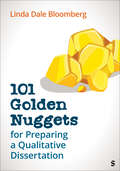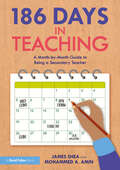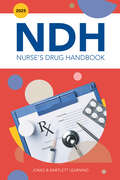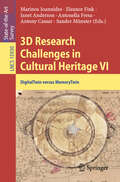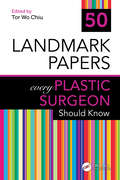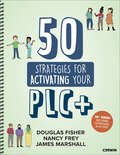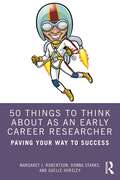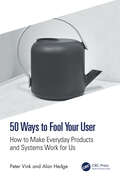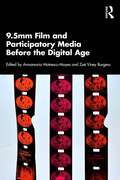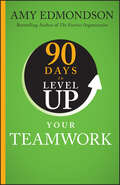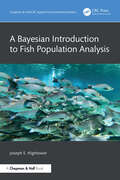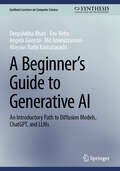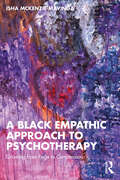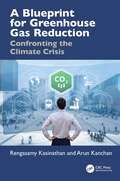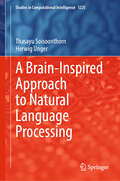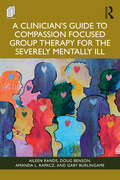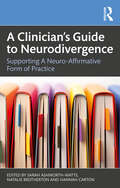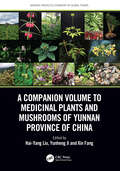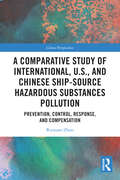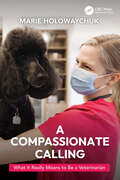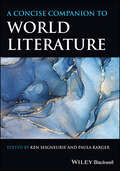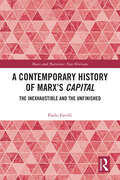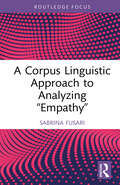- Table View
- List View
101 Golden Nuggets for Preparing a Qualitative Dissertation
by Linda Dale BloombergThe 101 "nuggets of understanding" that comprise this book shed light on the required content of a qualitative dissertation. They help readers navigate through the iterative, recursive, and often messy dissertation process, from its inception to a successful completion right from the planning stage, through data collection and analysis, all the way to writing up, presenting, and publishing. Each nugget is posed in the form of a question, as if in conversation with the reader, and will hopefully stimulate critical thinking, reflection, and dialogue. This book is the place to turn to for quick (though not simplified) answers to key questions based on the latest developments in the field of qualitative research. It will motivate doctoral students or prospective doctoral students to seek and consult additional relevant texts and resources in order to delve deeper into the many issues involved in preparing for a qualitative dissertation.
101 Golden Nuggets for Preparing a Qualitative Dissertation
by Linda Dale BloombergThe 101 "nuggets of understanding" that comprise this book shed light on the required content of a qualitative dissertation. They help readers navigate through the iterative, recursive, and often messy dissertation process, from its inception to a successful completion right from the planning stage, through data collection and analysis, all the way to writing up, presenting, and publishing. Each nugget is posed in the form of a question, as if in conversation with the reader, and will hopefully stimulate critical thinking, reflection, and dialogue. This book is the place to turn to for quick (though not simplified) answers to key questions based on the latest developments in the field of qualitative research. It will motivate doctoral students or prospective doctoral students to seek and consult additional relevant texts and resources in order to delve deeper into the many issues involved in preparing for a qualitative dissertation.
186 Days in Teaching: A Month-by-Month Guide to Being a Secondary Teacher
by James Shea Mohammed A. Amin186 Days in Teaching provides a month-by-month roadmap for the school year, helping secondary teachers quickly adapt to new environments, accomplish the many tasks expected of them and excel in roles that might be unfamiliar or outside their initial training.The book covers all aspects of teaching and learning as well non-teaching responsibilities, ensuring you know exactly what is coming up and how to prepare for it successfully. By offering practical advice, research-based strategies and evidence-informed approaches, this guide helps teachers navigate the annual cycle of school life while building the necessary skills and knowledge to remain adaptable and accelerate their careers. Key topics include retaining autonomy, curriculum design, pastoral care and effective communication. Drawing on well-known theories of community practice, it empowers teachers to become active agents in shaping their school’s ethos and teaching practices.With a focus throughout on your well-being and job satisfaction, this is essential reading for all secondary teachers, especially those new to the profession, aiming to build a fulfilling, sustainable career in a diverse education landscape.
2025 Nurse's Drug Handbook
by Jones & Bartlett LearningThe 2025 Nurse's Drug Handbook is an up-to-date, practical, comprehensive and user-friendly drug reference guide for current nursing students and practicing nurses alike. Written in a straightforward style with approachable terminology, it offers concise and consistently formatted drug entries organized alphabetically from A-Z. The 2025 Nurse’s Drug Handbook ensures that all nurses, both new and experienced, can easily access accurate information they need before administering any medication, ensuring proper patient care and safety.
3D Research Challenges in Cultural Heritage VI: DigitalTwin versus MemoryTwin (Lecture Notes in Computer Science #15930)
by Janet Anderson Antonella Fresa Sander Münster Marinos Ioannides Eleanor Fink Antony CassarThis book presents a collection of papers focussing on 3D digitisation in the domain of cultural heritage. The use of data acquisition technologies in digitising cultural heritage holds great potential for preserving and disseminating the history of mankind. However, to exploit these opportunities in full, comprehensive guidelines for documenting the process of digitisation are required. Only then can the efficiency and credibility of digital representations be assured.
50 Landmark Papers every Plastic Surgeon Should Know (50 Landmark Papers)
by Tor Wo ChiuThis book identifies the key scientific articles in the field of Plastic Surgery and explains why these papers are important in contemporary clinical management.The text includes commentaries on landmark papers in a wide range of clinical areas within Plastic, Reconstructive, and Aesthetic Surgery. These are not necessarily the most cited in their field, though many of them are. Reviewers were asked to pick a paper in their field of expertise that, in their view, should be read more carefully, and they have selected papers that they are passionate about – and may have (co)authored – and which underpin the care of patients. Further, the insights offered will stimulate further reading and will facilitate a deeper understanding of a topic and, of course, be useful in examinations.This an invaluable reference for Plastic Surgery trainees, fellows, and surgeons studying for exams, as well as for seasoned clinicians who want to stay current in their field.
50 Strategies for Activating Your PLC+
by James Marshall Douglas Fisher Nancy Frey50 Strategies for Activating the Full Potential of Your PLC+ Team Are you maximizing the impact of your professional learning communities? 50 Strategies for Activating Your PLC+ equips educators with the tools and actions needed to foster highly effective PLC+ teams. Successful PLCs are built on a foundation of strong collaboration, unified purpose, trust, and effective communication. The 50+ strategies in this essential guide address the challenges and possibilities within teacher teams by focusing on the role of activators, group members who work to ensure that all members of the PLC+ contribute to meaningful, solution-driven progress. Grounded in experience and practical guidance, this resource is designed to make every step of your PLC+ experience impactful. With strategies organized into eight comprehensive sections, the authors provide the frameworks necessary to create an engaged, productive learning culture with: Eight categories of strategies aligned with the five guiding PLC+ questions to support targeted and actionable leadership A practical cross-reference table connecting the strategies to content with additional context and insights to deepen understanding Tools for developing activator skills that enhance facilitation, decision-making, and solution-oriented collaboration within your PLC+ teams Concrete protocols and frameworks for addressing team dynamics, meeting structures, and continuous improvement From establishing goals to reviewing results, you′ll find purposeful actions that drive positive outcomes for educators and students alike. Take the next step in your PLC+ leadership to shape the future of learning in your school.
50 Strategies for Activating Your PLC+
by James Marshall Douglas Fisher Nancy Frey50 Strategies for Activating the Full Potential of Your PLC+ Team Are you maximizing the impact of your professional learning communities? 50 Strategies for Activating Your PLC+ equips educators with the tools and actions needed to foster highly effective PLC+ teams. Successful PLCs are built on a foundation of strong collaboration, unified purpose, trust, and effective communication. The 50+ strategies in this essential guide address the challenges and possibilities within teacher teams by focusing on the role of activators, group members who work to ensure that all members of the PLC+ contribute to meaningful, solution-driven progress. Grounded in experience and practical guidance, this resource is designed to make every step of your PLC+ experience impactful. With strategies organized into eight comprehensive sections, the authors provide the frameworks necessary to create an engaged, productive learning culture with: Eight categories of strategies aligned with the five guiding PLC+ questions to support targeted and actionable leadership A practical cross-reference table connecting the strategies to content with additional context and insights to deepen understanding Tools for developing activator skills that enhance facilitation, decision-making, and solution-oriented collaboration within your PLC+ teams Concrete protocols and frameworks for addressing team dynamics, meeting structures, and continuous improvement From establishing goals to reviewing results, you′ll find purposeful actions that drive positive outcomes for educators and students alike. Take the next step in your PLC+ leadership to shape the future of learning in your school.
50 Things to Think About as an Early Career Researcher: Paving Your Way to Success
by Donna Starks Margaret J. Robertson Gaelle HorsleyThis book for Early Career Researchers (ECRs) provides vital insights for jump-starting your research career and guidance on how you can find your own ways of knowing, being, doing, and communicating to progress your career.Charting a course through the first years of a research career, while retaining control of your life and your authenticity is more challenging than it has ever been. This book argues that there are multiple ways of being an ECR, and that research pathways are uniquely individual. It shows how to prepare yourself for your research journey and contains useful hints about preparing manuscripts, writing research grants, developing supervision skills, and forging a successful research career. Offering solutions to common challenges, it provides insights into preparing CVs, preparing for interviews and other opportunities for you and your career.Providing practical advice based on extensive experience, this book is essential reading for those completing, or who have recently completed, PhDs, as well as those in the early stages of their career in higher education.
50 Ways to Fool Your User: How to Make Everyday Products and Systems Work for Us
by Alan Hedge Peter VinkFrom the way we interact with our workspaces to the simple act of changing a duvet cover, the world around us is shaped by design, and not always for the better. This book offers an engaging look at how everyday objects and systems can confuse, frustrate or even hinder us, yet also explores how a better understanding of human behavior can lead to improvements. Written with humor and professional insight, 50 Ways to Fool Your User: How to Make Everyday Products and Systems Work for Us invites readers to question the quirks of modern life while imagining how things could work better for everyone. Across 50 chapters, scientific explanations are paired with snappy anecdotes. Each chapter concludes with actionable takeaways. Whether it’s struggling with unwieldy packaging, enduring the infamous middle seat on an airplane or navigating the frustrations of an AI call center, these relatable scenarios highlight the oftenoverlooked aspects of design that impact our daily lives. In the final chapter, the ideas are summarized into a neat practical ethos, offering ergonomic principles to inspire smarter, more thoughtful solutions in everything from technology to office furniture. Through reading this book, the reader will gather a view of what good and bad design looks like and how these examples can inform their work in designing better products, systems and services. This book is for professionals and academics interested in human factors, ergonomics and designing with the human in mind, but it is also interesting for every layman. It will appeal to designers, engineers and systems operators.
9.5mm Film and Participatory Media Before the Digital Age (Routledge Advances in Film Studies)
by Annamaria Motrescu-Mayes Zoë Viney BurgessThis anthology offers the first systematic exploration of 9.5mm amateur film culture, practice and consumption, from its launch in 1922 to the present day. It breathes new life into our understanding of participatory media and its origins in the early twentieth century, revealing how a web of experiences gave rise to a vibrant ecosystem of collaborative storytelling and grassroots cultural movements that continue to shape our understanding of media participation. The collection brings together the work of emerging specialists, early-career researchers, and respected scholars from anthropology, film, media studies and international film archival networks. The 16 chapters in this volume offer fresh insights into early participatory media culture and confirm the ongoing influence and impact of 9.5mm film on global media studies. The interdisciplinary approach and wide‑reaching perspectives make it a valuable resource for cinema and media curricula, film archival projects, cultural and media anthropology, visual sociology, as well as gender, memory and migration studies.
90 Days to Level Up Your Teamwork (90 Days to Level Up Series)
by Amy C. EdmondsonSupercharge your teamwork skills in just three months with expert advice from an industry leader In 90 Days to Level Up Your Teamwork, bestselling author Amy Edmondson teaches you how to become a better team player by focusing on a specific element of cooperative achievement each week. From overcoming barriers to creating psychological safety, this book walks you through exactly how to develop your teamwork skills, one step at a time. Inside you'll find: A crystal-clear, week-by-week roadmap to help you improve your teamwork skills Practical tasks and actionable steps you can apply immediately to become a better teammate Thoughtful prompts to help you think about how what you've learned applies to your own career If you're ready to transform your career and achieve your goals in just one quarter, the 90 Days to Level Up series is for you. Whether you're brand-new to a business, stepping into a leadership role for the first time, or looking to enhance your skills, this series will be your personal guide to unlocking your potential and reaching new professional heights.
A Bayesian Introduction to Fish Population Analysis (Chapman & Hall/CRC Applied Environmental Statistics)
by Joseph E. HightowerFisheries science is an applied field. A biologist working on a depleted population might need to forecast the population trajectory or examine which factors are limiting recovery. For an exploited population, a biologist might investigate whether the fishery or the stock would be improved through harvest regulation, such as a quota or size limit. Addressing those sorts of questions generally involves estimating parameters such as population size or survival rate. An essential step is characterizing the degree of uncertainty in results, which can be substantial for fisheries models. Bayesian methods and current software provide a flexible and powerful framework for addressing these challenges. Models developed using Bayesian software can be tailored to the unique aspects of each field study.A Bayesian Introduction to Fish Population Analysis is aimed at advanced undergraduate and graduate students as well as working professionals interested in a hands-on introduction to Bayesian approaches for fitting fisheries models. Chapters address key aspects of population dynamics: abundance, mortality, growth, and recruitment. The book includes complete R code for simulating each study design and JAGS Bayesian code for model fitting; code files are also available online. No prior knowledge of R or JAGS is assumed and new commands are introduced gradually through the sequence of examples. There is emphasis throughout the book on how to vary simulation settings to develop intuition about fisheries models (e.g., how many fish should be tagged in order to obtain usefully precise results). Additional topics include development of integrated population models, model checking, model selection, and uninformative and informative prior distributions.Key features include: The book begins with a focus on ecologically relevant probability distributions (e.g. binomial, Poisson, normal, lognormal) as a foundation for the applied fisheries chapters. Subsequent chapters demonstrate Bayesian approaches for estimating abundance, mortality, growth, and recruitment. Full open-source code is provided for simulation and plotting using R and Bayesian model fitting using JAGS. The book demonstrates how simulation can be used to gain a deeper understanding of analytical methods and for planning field studies. Joseph E. Hightower is a professor emeritus in the Department of Applied Ecology at NCState University. His research interests focus on fish population dynamics, especially field andanalytical methods for estimating population parameters. His primary teaching role was agraduate course in quantitative fisheries management, including Bayesian methods that serveas the foundation for this book.
A Beginner’s Guide to Generative AI: An Introductory Path to Diffusion Models, ChatGPT, and LLMs (Synthesis Lectures on Computer Science)
by Deepshikha Bhati Fnu Neha Angela Guercio Md Amiruzzaman Aloysius Bathi KasturiarachiThis book is the essential guide for anyone curious about AI’s creative power. In the rapidly evolving landscape of artificial intelligence, generative AI stands out as one of the most transformative technologies of our time. Designed for beginners and requiring no prior knowledge of AI, this book breaks down the fundamentals of generative AI, from text and image generation to the workings of models like ChatGPT and Google Bard. The authors provide step-by-step coverage of the essential concepts and techniques that power generative AI. From the basics of how machines learn to generate text and images, to the intricate workings of models like Transformers, ChatGPT, and Google Bard, readers will gain a solid foundation in AI's most cutting-edge tools. Rather than focusing on a single method, the authors introduce a spectrum of generative modeling techniques, including diffusion models, variational autoencoders, and transformers. This comprehensive exposure ensures readers will be well-prepared to understand and adapt to the rapidly evolving AI landscape. In addition, real-world applications of generative AI across various industries are explored including healthcare innovations, business analytics, and legal technology, and the authors provide practical insights and examples that show how generative AI is revolutionizing these fields.
A Black Empathic Approach to Psychotherapy: Growing from Rage to Compassion
by Isha McKenzie-MavingaThis book presents the concept of a black Empathic Approach, an experientialmodel used as a means of developing powerful feelings associated with racism,such as fear, guilt, and rage, into a useful THERAPEUTIC tool for healing theintersectional impact of anti- black racism and associated oppressions.Providing a framework for training, continued professional development, andtherapeutic client work, this book explains the concept of the black EmpathicApproach and discusses its usefulness in addressing racialization in a therapeuticcontext. It helps readers to unpick their use of empathy as a generic concept anddevelop it as a skill that can be used to assist others in addressing the trauma andimpact of racism. Through a series of honest and transparent personal vignettes,Dr. McKenzie- Mavinga shares her own learning experience and personal growthfrom feelings of rage about racism to developing the approach and transformingpain into compassion. Chapters support processing, engagement and dialogue withcontexts of anti- black racism in psychotherapy and counsellor training to providea powerful framework for therapeutic discussion, teaching, learning and practice.This book is intended for therapists, coaches, support workers, social workers,training institutes, and anyone else attempting to support individuals and groupsimpacted by racism.
A Blueprint for Greenhouse Gas Reduction: Confronting the Climate Crisis
by Rengasamy Kasinathan Arun KanchanThis comprehensive book details greenhouse gas (GHG) emissions across a range of sources, sectors, and countries, with particular emphasis on the United States and other developed nations. It presents an in-depth analysis, covering the roles of industries, policymakers, and regulatory frameworks in contributing to and mitigating GHG emissions. The authors discuss emission measurement and monitoring methodologies, supported by real-life case studies illustrating how corporations, policymakers, and industry leaders can implement responsible decarbonization strategies. Additionally, it covers the critical verification aspect of enforcing climate policies and regulations.Features Provides a detailed sector-wise breakdown of GHG emissions across energy, transportation, industry, and agriculture. Explains the scientific basis of emissions and their regulatory frameworks governing them under global agreements such as the Paris Agreement and U.S. EPA policies. Presents recommendations for energy-efficient strategies and key actions that industries and policymakers can adopt to reduce GHG emissions. Highlights AI, big data, and IoT as tools for carbon monitoring and emission tracking. Offers guidance for professionals and scholars on estimating emissions and implementing reduction methods at both organizational and policy levels. This book is essential for environmental and energy professionals, policymakers, corporate sustainability officers, researchers, and industry leaders engaged in emissions reduction, regulatory compliance, and climate policy. It is also a valuable resource for EHS personnel, facility administrators, students, and faculty studying and teaching the environmental impacts of GHG emissions.
A Brain-Inspired Approach to Natural Language Processing (Studies in Computational Intelligence #1225)
by Herwig Unger Thasayu SoisoonthornThis book brings together key ideas from neuroscience and artificial intelligence to show how they can work together. It helps readers understand how studying the brain can lead to more adaptable and efficient AI systems. Instead of treating the two fields as separate, it highlights how brain-inspired models can help overcome current challenges in AI, improve existing techniques, and spark new and creative solutions.The journey begins with the biological foundations of intelligence, focusing on the brain&’s structure, evolution, and functions, particularly the neocortex, which plays a central role in learning and prediction. Building on this foundation, the book surveys both traditional and modern AI methods in an accessible way and offers a critical analysis of their strengths and shortcomings. The discussion then moves from theory to practice, showing how brain-inspired ideas can be applied to real-world Natural Language Processing (NLP) tasks such as spelling correction and Thai word segmentation, where conventional models often struggle with nuance and complexity. In its final sections, the book reflects on the broader significance of integrating neuroscience and AI, encouraging continued exploration and innovation at the intersection of these disciplines. Key benefits of this book include: - Exploring biologically plausible models of intelligence to open new pathways- Gaining foundational insights into how neuroscience can inform AI design- Presenting practical examples to enhance NLP tasks in complex languages- Offering a testbed for experimentation with brain-inspired computational models- Serving as a valuable resource for advanced students, researchers, and professionals seeking to deepen their understanding of nature-inspired intelligent systems While refining existing AI models may lead to meaningful progress, it remains uncertain whether such approaches alone can achieve a deeper form of intelligence. By contrast, drawing inspiration from the structure and function of the human brain may offer a promising direction toward creating systems that are more flexible, adaptive, and capable of exhibiting human-like behavior.
A Clinician's Guide to Compassion Focused Group Therapy for the Severely Mentally Ill
by Doug Benson Gary Burlingame Aileen Rands Amanda L. RapaczThis manual provides clinicians with guidance to conduct compassion focused group therapy with patients suffering from severe forms of mental illness.Historically, those suffering from severe forms of mental illness face a myriad of biological, psychological, and social challenges, particularly shame and self-criticism. Compassion focused therapy is known to combat and address this suffering. This manual connects rich biological, psychological, and social theory with empirical findings and lived clinical experience. Comprising 12 modules, this clinician’s guide presents psychoeducation in conjunction with intrapersonal/interpersonal exercises and process-oriented instructions to aid treatment and guide group therapy sessions.This book, created by clinicians for clinicians, is a vital resource for psychiatrists, psychologists, social workers, or substance use disorder counselors, offering compassion focused group therapy in an inpatient setting.
A Clinician’s Guide to Neurodivergence: Supporting a Neuro-Affirmative Form of Practice
by Sarah Ashworth-WattsA Clinician’s Guide to Neurodivergence: Supporting a neuro-affirmative form of practice is a concise handbook which provides a comprehensive and accessible overview of a range of conditions to support clinicians working with individuals with diverse neurocognitive profiles. It provides a practical guide for clinicians to move towards a more neuro-aware and neuro-affirmative way of working. It sets out guidance around diagnosis and access to services whilst giving consideration to the adaptations and accommodations that might be necessary to avoid the inequities that can often be experienced through neuro-normative or heteronormative practices.Topics covered include learning difficulties such as Dyslexia and Dyscalculia, Autism, ADHD, acquired brain injury and various other neurodivergent profiles. The intersection of neurodivergence with factors such as gender and age and comorbidity with mental health and personality profiles are also considered. Drawing on the NICE guidelines, the International Classification of Disease (ICD) system, and the Diagnostical Statistical Manual (DSM), each chapter provides the background to different neuro-cognitive profiles, common indicators that may be observed, screening and diagnostic assessment, clinical recommendations and signposting to relevant resources and services.It is valuable reading for students, researchers, clinicians, therapists, medical and allied professionals who require an introductory text providing in-depth details regarding a range of neurodivergent conditions.
A Companion Volume to Medicinal Plants and Mushrooms of Yunnan Province of China (Natural Products Chemistry of Global Plants)
by Yunheng Ji Hai-Yang Liu Xin FangThe old saying “no prescription can be made without Yunnan medicinal materials” suggests the profound heritage and extensive influence of Yunnan's ethnic medicine culture and medicinal plant resources. This book, A Companion Volume to Medicinal Plants and Mushrooms of Yunnan Province of China, continues the systematical introduction of the plant morphological characteristics, medicinal history, resource situation, traditional uses, ethnopharmacology, phytochemicals, pharmacological effects, biosynthesis, and sustainable utilization of some important or endemic medicinal plants and mushrooms of Yunnan Province of China, including Amomi Fructus, Amomum tsaoko, Angelica sinensis, Aucklandia costus, Gentiana rigescens, Phyllanthus emblica, and Polygonatum kingianu, Tricholoma matsutake, etc. Furthermore, this book offers strategies and advice for sustainable utilization and rational exploitation of medicinal plant resources in Yunnan, drawing on the basis of the author's years of practice in the field. Reviews species-specific natural products discovered from Yunnan medicinal plants, and their bio-activities. Provides a brief introduction to the commercial drugs and health products developed based on these medicinal plants. Discusses the resource availability and conservation status of these medicinal plants. For those threatened species, the causes of their endangerment are summarized and conservation strategies are proposed. Enhances understanding with high-quality original photographs and illustrations of the plants, their habitats, and usage in traditional remedies.
A Comparative Study of International, U.S., and Chinese Ship-Source Hazardous Substances Pollution: Prevention, Control, Response, and Compensation (China Perspectives)
by Ruixuan ZhuoThe book systematically discusses how to better regulate and reduce ship-source hazardous substances pollution. It analyzes international, U.S., and Chinese laws and regulations from the perspectives of pollution prevention and control, emergency response and environmental remediation, and liability and compensation for damage.Through case studies of major ship-source hazardous substances pollution incidents in the United States and China, the author concludes that prevention, control, and response measures must be considered alongside conflicts between pollution control objectives and other economic, social, and political constraints. Additionally, in China, prevention, control, and response efforts are constrained by a narrow definition of damage, insufficient liability limits, and underdeveloped insurance and supplementary funding mechanisms, despite the consideration of environmental claims in the compensation regimes. The author calls for adequate legal institutions that include discharge standards and permits, emergency response protocols, strict compensation standards, limited defenses, a supplementary compensation fund, and comprehensive enforcement that integrates national regulations and international cooperation.This book serves as a useful reference for students, scholars, and legal professionals specializing in shipping, maritime, and environmental law.
A Compassionate Calling: What It Really Means to Be a Veterinarian
by Marie HolowaychukA Compassionate Calling offers an unflinching and deeply personal look into the realities of the veterinary profession.Dr. Marie Holowaychuk, a veterinary specialist with experience in academia, emergency and referral hospitals, and general practice, weaves candid personal stories with evidence-based insights from published research. In 40 concise and thought-provoking chapters, she explores the hidden curriculum of veterinary school, the toll of on-call work, the emotional impact of euthanasia, the challenges of practicing during a pandemic, and many other important topics. Marie also tackles pressing issues like diversity, equity, inclusion, and the evolving dynamics of pet insurance and corporatization in veterinary medicine.Despite nearly 90% of pet owners viewing their animals as family members, few truly understand the challenges veterinarians face daily. This book pulls back the curtain to address questions such as: Why don’t some veterinarians recommend the profession to others? How do distressing events, like euthanasia and moral stress, affect veterinarians’ mental health? What do veterinarians wish pet owners knew about the emotional and mental toll of caring for their animals? With its blend of heartfelt storytelling and practical insights, A Compassionate Calling is essential reading for pet owners, aspiring veterinarians, and anyone curious about the veterinary profession. Practicing veterinarians will also find comfort and connection in its honest exploration of the joys and struggles of veterinary life.
A Concise Companion to World Literature
by Ken Seigneurie Paula KargerProvides a student-friendly introduction to World Literature Bridging the gap between introductory materials and advanced scholarly research, the Concise Companion to World Literature offers a streamlined selection of the most popular and essential essays from The Companion to World Literature, specifically tailored for undergraduate students and instructors. This single-volume resource, edited by Ken Seigneurie and Paula Karger, presents 100 carefully curated chapters, fully revised for clarity and accompanied by newly commissioned essays. The Concise Companion, which retains the original work's three-tiered organizational structure—period essays, thematic bridge essays, and author-title chapters—offers a nuanced exploration of major literary traditions across time and geography. Each entry contextualizes major literary works within the broader framework of global literary traditions, enriching discussions on periodization, literary movements, and cross-cultural connections. With its accessible scholarship and enhanced learning tools, it is a vital resource for students beginning their journey in World Literature and for educators seeking a structured, easy-to-use reference. Providing an engaging approach to the vast landscape of global literary traditions, the Concise Companion to World Literature: Features an entirely new introductory section that offers contemporary perspectives on World Literature Showcases a diverse array of global texts, authors, and traditions to deliver a broad and inclusive literary perspective Addresses key debates in World Literature, including periodization, cross-cultural exchange, and literary historiography Includes a new pedagogical supplement to assist instructors in course design and aid students in literary analysis The Concise Companion to World Literature, designed for second- and third-year undergraduate students, is an essential resource for courses in World Literature, Comparative Literature, and Humanities programs. It is also a valuable tool for graduate students and faculty seeking an authoritative and easy-to-use reference for teaching and research in the field.
A Contemporary History of Marx’s Capital: The Inexhaustible and the Unfinished (Marx and Marxisms)
by Paolo FavilliPaolo Favilli provides both students and scholars with an original reading of themes and issues found in Karl Marx’s Das Kapital and its connections with present- day challenges. By way of continuous cross- referencing between present and past, Favilli demonstrates that claims regarding the scientific status of Das Kapital, advanced by countless texts since its original publication, are themselves deeply imbued by the ‘spirit of the times’. If in 1963 Jean-Paul Sartre could write that Marxism was the unsurpassable philosophical horizon of our times, what could make an undergraduate student today consider such a claim plausible?Informed by the latest research on Marxist theory and decades of teaching the Philosophy of History, Favilli employs a didactic approach stimulating student engagement and learning opportunities in the classroom. This approach allows for a better understanding of relationship between the present and the multiple temporalities that characterise and periodise the contemporary era. What follows is a critique of the contemporary academy for its hangover of post-1989 nuovismo (cult of novelty) and inability to make the proper distinctions between Marxism-as-party-state, the works of Karl Marx, and Marxism as an object of history. This led to the spectacle where after 1989, those who had spent most of their careers as Marxist-hued scholars not only abandoned this identity but also spurned any recognition that Marx and Marxism were worthwhile objects of enquiry.This book was first published in Italian as A proposito de ‘Il capitale’..., Il lungo presente e i miei studenti. Corso di storia contemporanea (Milan: FrancoAngeli, 2021). This English translation includes a new foreword by the author.
A Corpus Linguistic Approach to Analyzing "Empathy" (Routledge Focus on Applied Linguistics)
by Sabrina FusariThis volume offers an in-depth corpus linguistic analysis of the word “empathy” aiming to foster unique insights into a word widely found across contemporary discourses and into methodological innovations for analyzing large corpora. Given the understanding of empathy’s importance for individual and social development, A Corpus Linguistic Approach to Analyzing “Empathy” demonstrates the potential of a corpus approach to shed new light on a significant yet difficult-to-define concept. Fusari systematically applies the use of concordances and other corpus output to derive patterns and recurrent phraseologies in the 36+ billion-word electronic corpus, English Web 2020, to help readers grapple with key ideas around empathy. Such questions include what we really mean by empathy, whether it is always positive, whether it is learned or innate, and whether empathy is truly what “makes us human”. The book contends with these questions across disciplines, from the clinical to the psychological and philosophical to the linguistic and discursive. Opening new areas of research into inclusive language and the use of corpus tools to analyze individual terms, this book will be of interest to students and scholars in corpus linguistics and applied linguistics, as well as such fields as cognitive science, psychology, philosophy, and allied health.
